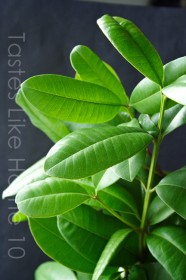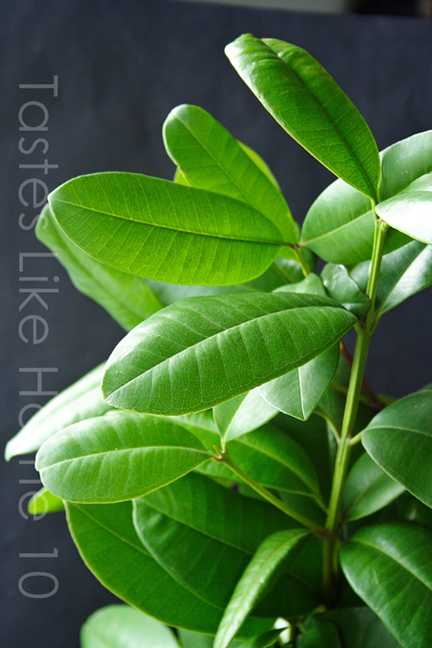Hi Everyone,
Tear or crush a fresh bay leaf with your hands and smell it and you’ll quickly understand why it is the most widely used culinary herb. The origins of this evergreen bay laurel tree lie in the Mediterranean.
 Here in the English-speaking Caribbean we simply call it bay leaf or sweet bay, in other parts of the Caribbean it is also known as the spice leaf – as a result of its highly fragrant and aromatic notes of cinnamon, cloves, nutmeg and lemon with nuances of vanilla and cardamom. Depending on which part of the world you live or are from, you will be familiar with the Turkish bay leaf, the Indonesian bay leaf, the California bay leaf and the Indian bay leaf, (Tajpeta). The variety we get here in the Caribbean is categorized as West Indian bay. The varieties of bay leaves (Turkish, Indian etc.) vary in the flavour and the intensity of said flavour. They also differ in appearance.
Here in the English-speaking Caribbean we simply call it bay leaf or sweet bay, in other parts of the Caribbean it is also known as the spice leaf – as a result of its highly fragrant and aromatic notes of cinnamon, cloves, nutmeg and lemon with nuances of vanilla and cardamom. Depending on which part of the world you live or are from, you will be familiar with the Turkish bay leaf, the Indonesian bay leaf, the California bay leaf and the Indian bay leaf, (Tajpeta). The variety we get here in the Caribbean is categorized as West Indian bay. The varieties of bay leaves (Turkish, Indian etc.) vary in the flavour and the intensity of said flavour. They also differ in appearance.
The Turkish and California bay leaves appear similar in appearance – they are long and slender and the leaves are thin but somewhat sturdy. The Indian bay leaves are longer and wider than the Turkish and California leaves, they average about 3 and a half to 4 inches in height and span a width anywhere from 1 to 1 and a half inches. The Indian bay leaf is distinguished by the three prominent veins that run along the length of the leaf. The Indonesian bay leaf is like a bigger version of the Turkish and California bay leaves; however the colour of the leaves is a brighter green. The West Indian bay leaf varies in size, I have seen leaves as long as 5 inches and as wide as 2 and a half inches. The leaves are thick and the colour ranges from bottle green to light green. The newer, younger leaves are light green and not as flavourful, it is best to use the more mature, darker leaves for the full flavour. The West Indian bay leaf has a more rounded shape whereby the other bay leaves are long, slender and pointed at the tip.
Available all year round, bay leaves are primarily sold in their dry form though these days many markets and supermarkets carry the fresh variety. Of course if you live in a country where there are thriving bay leaf trees all around, using dry bay leaves would be an afterthought. Dried bay leaves will always be a big seller because it is an herb that retains the depth of it flavour that gets released when cooked for long periods and low and slow. I have used both kinds of bay leaves – fresh and dried and have found that both work equally well in terms of imparting flavour. The fresh bay leaf, however, immediately starts to release its essential oils and flavour as soon as it is added to the pot. You can smell it right away! Using the fresh variety offers an opportunity to get a unique flavour to your food without the long cooking that would be need if using the dry variety.

The flavour of bay leaves is said to be characteristic in the cuisines of Brazil, Greece, Germany, Eastern Europe, Jamaica, Scandinavia and Cuba. Here in the Eastern part of the Caribbean the bay leaf is more used for teas and to infuse hot breakfast options such as porridges. Yes, it is used in soups, stews, casseroles, rice and peas and the like but it is more well known in these parts as an ingredient to make tea and to aid in digestion or as a concoction to lower blood sugar levels, relieve headaches, arthritis pains and more recently I heard, aid in getting a good night’s rest. If you are having difficulty falling asleep, drink a cup of bay leaf tea and you’d be off to la-la-land in no time. I am yet to test that theory. What all of this says is that we use the bay leaf, first, for its folk properties.
The natural cocoa sticks made in these parts are made up of the ground cocoa pods, a hint of cinnamon and bay leaves. Man, when you put one of those sticks to boil and throw in a couple of fresh bay leaves, you will want to bottle that fragrance! Febreeze and Glade would be so jealous! It is not just the aroma though; it is the taste that is so wonderful and so hard to describe that engages your senses. It’s like aromatherapy.
A cup of fresh all-bay leaf tea is something that I wish everyone can experience. Oh and when you pair it up with lemongrass… I have to stop. I am having a moment here. Lemongrass and bay leaf tea – have a cup and you’ll find yourself whispering aloud: “Where have you been all my life?!” It’s that good!
The next time you are making some porridge like sago, cornmeal, barley, oats etc. Throw in a fresh bay leaf from the onset and smell and taste the difference.
Apart from flavouring food and making excellent hot beverages and porridges, bay leaves are also used as insect repellent. Uh huh, you heard me right. I am always concerned about ensuring that I store things properly in this hot climate we have and so I am constantly checking the cupboards to ensure that nothing is gathering moths etc and then my helper told me: “Just throw a few bay leaves in the cupboard and you won’t have to worry.” And you know what? It totally works! About every other month or so, I remove the old bay leaves and throw in some fresh ones – my cupboard is fresh and I don’t have to worry about insects!
The bay leaf is one of those essential items to have in your kitchen. Fresh bay leaves last well when wrapped in paper towels in the fridge but it you find that you have too much on hand, dry them in the sun as is or in a brown paper bag. If it is not sunny where you are then air dry them for a few days then put them in an airtight bottle and store them in a cupboard. One thing to always remember is that the bay leaf should be used judiciously when cooking, too much and it can overpower. Always be guided by your recipe.
I’m off now to go make some sweet bay tea.
Cynthia
Cynthia@tasteslikehome.org
www.tasteslikehome.org

